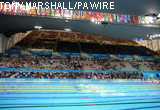 It’s my first day off from the Games today, as all the race swimming has finished, with diving and synchronised swimming still to go. With a major Olympic day in store – men’s’ tennis and 100 metres, finn class sailing, Pistorius and the women’s marathon and 400 metres, I went for a bit of Olympic culture. The Queen’s Gallery at Buckingham Palace is showing the anatomical drawings of Leonardo da Vinci, the first public exhibition of these extraordinary works. And what a revelation.
It’s my first day off from the Games today, as all the race swimming has finished, with diving and synchronised swimming still to go. With a major Olympic day in store – men’s’ tennis and 100 metres, finn class sailing, Pistorius and the women’s marathon and 400 metres, I went for a bit of Olympic culture. The Queen’s Gallery at Buckingham Palace is showing the anatomical drawings of Leonardo da Vinci, the first public exhibition of these extraordinary works. And what a revelation.
Many are shown on both sides, as da Vinci made his notes and drawings on both sides as if paper was valuable, as perhaps it was in those days, sometimes on completely different subjects. The exhibition is subtitled Inside his mind, inside the body. With the free audio commentary on head sets (read by Derek Jacobi, with several anatomists, and art historians comments included), this was an expert tutorial on these drawings, and on the artist, that made so much about him clearer.
For instance, his genius was hampered by his prolific talent, and, without another mind to keep him on course, he would veer from mechanics to architecture and back to anatomy again. His most productive time in anatomy was when he worked with professor of anatomy at Pavia, Marcantonio della Torre, who not only provided him with human subjects for dissection but kept him focused on his project of a textbook of anatomy that was actually based on dissection and not theory.
His insights from this time, as at others, astonish us because they are so brilliant, and at the same time are so far ahead of any other researcher, that he was not able to make some leaps of knowledge that seem obvious to us today. He overthrew medieval theory about the structure of the brain by using his knowledge of the lost wax process for casting statues, injecting hot wax into the brain, then dissecting out the cast
This showed for the first time the structure of the three ventricles and confounded the earlier theory that their functions were perception, reasoning, and memory. Then he dissected the perineum, and tried to work out how the anal sphincter worked. All his previous research had been on skeletal muscles, and he had never seen a muscle that formed a circle, so he tried to see the anus as surrounded by a group of muscles that grew thicker as they contracted, thus closing or opening the orifice.
Wrong, but look at his drawing (click on the picture and an enlarged version appears that you can steer around the image with your mouse). Look at his theoretical anal sphincter – recognise it? It’s the same structure as an ion channel, that does work as Vinci theorised. Da Vinci even chose five muscles to match the five proteins that we now understand make up the channel.
Da Vinci’s discoveries in anatomy would have revolutionised medicine in the 16th century, but his book was never published and his drawings stayed lost for 400 years. If you are in London, don’t miss them. Go to see the exhibition, “Leonardo da Vinci: Anatomist. Inside his mind, inside the body”, at the Queen’s Gallery until early October. If you aren’t, you can see all the drawings online at this link.
See also previous blogs about this exhibition.
John Davies is a consultant anaesthetist in Lancaster, who takes part in motorsport as a competitor and as a rally doctor. He is volunteering as part of the Olympic games medical team in the aquatic centre. Over the next couple of weeks he will be blogging from the Olympic Park about his experience during the Olympic games.
